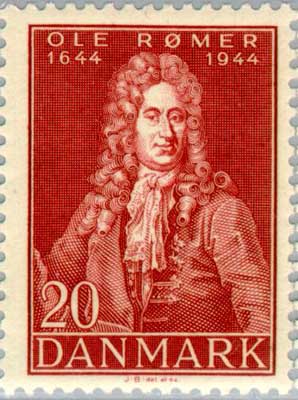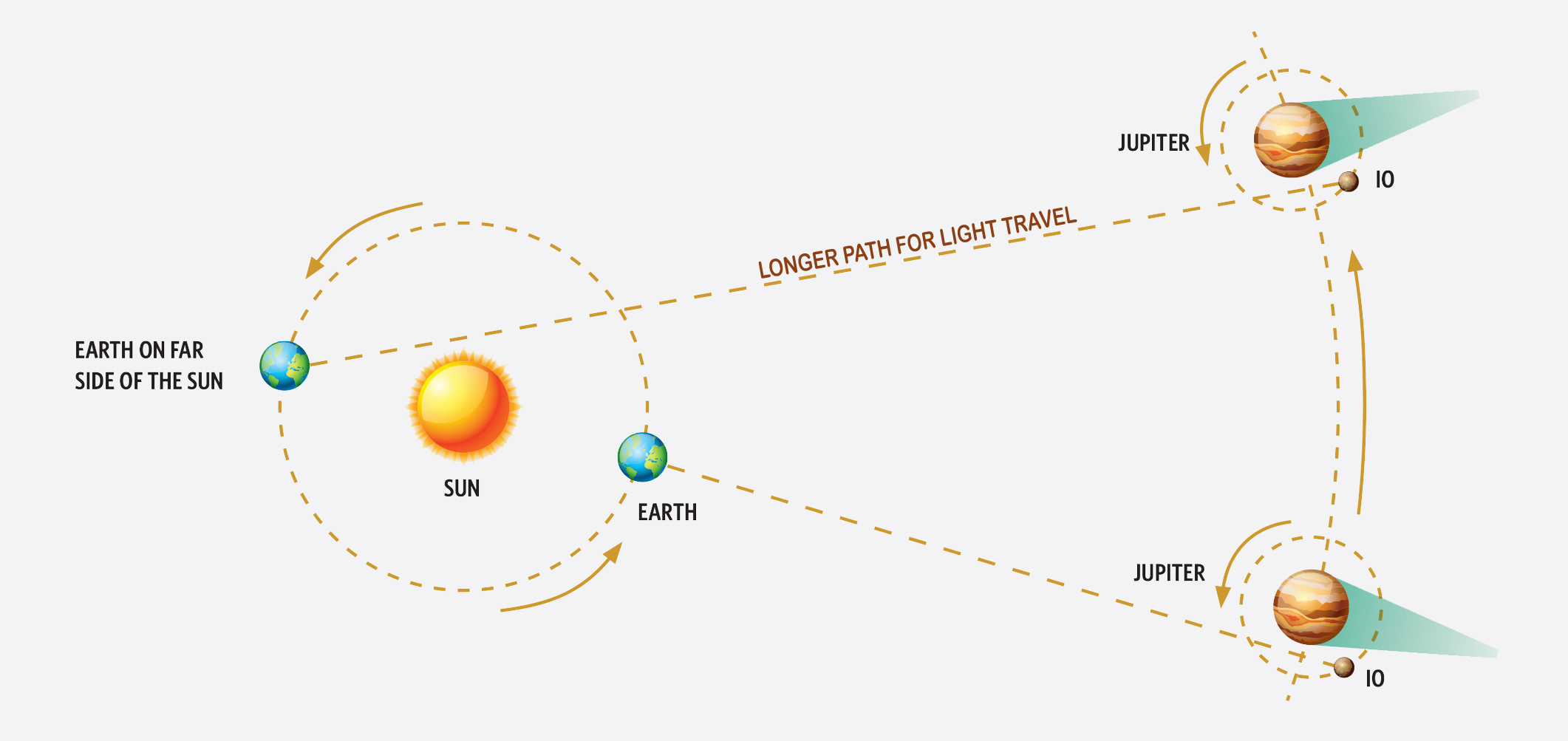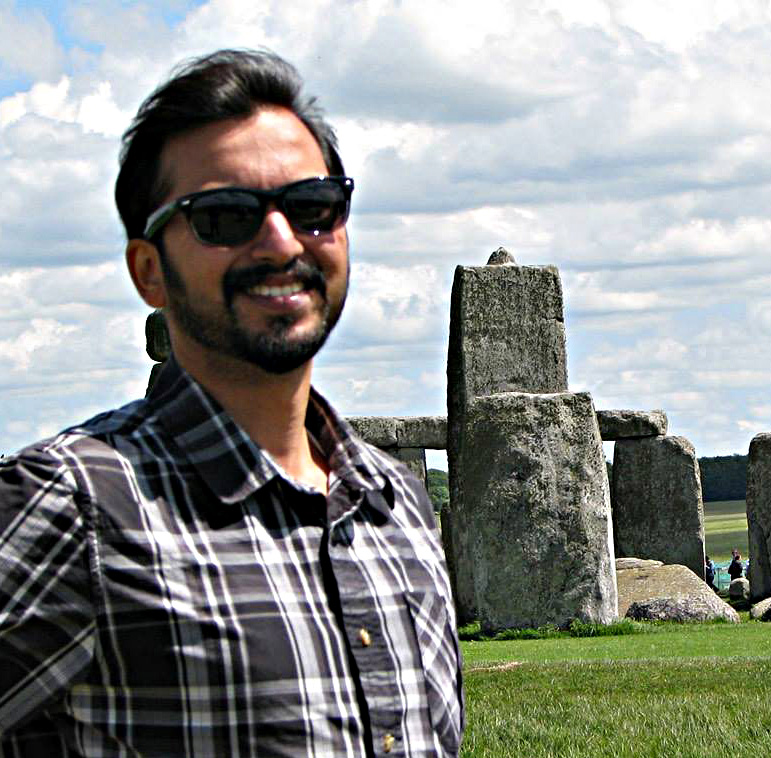GAM 2017 Blog
- Published: Saturday, April 15 2017 00:00
By Samir Dhurde
 a representative image
a representative image
If you diligently do the previously mentioned study of the motions of the Galilean Moons, then you may want to continue a bit more on the lines of an important study that lead to one of the first, close-to-accurate measurements of the speed of light... and this is the best time to start trying the method yourself!
Extraordinarily Fast
Before the 17th century we believed that there was no such thing as the "speed of light". It was thought that light could travel any distance in no time at all. In 1638, the great Galileo Galilei was probably the first person to try to determine the speed of light. His experiments however were conducted over small distances on the Earth and the timing instruments available to him were not very precise. Hence, he could only confirm that the propagation of light is "if not instantaneous, then extraordinarily fast". Today we know that, given such short distances and the very great speed of light, it was quite remarkable that he at least tried.
Olé! Another Cheer for Astronomy
Back in the mid-1600s astronomers were measuring the orbital periods of Jupiter's four largest moons. They too were using the convenient period of the Opposition of Jupiter for these measurements. However, when they timed the same after the Opposition, they were in for a surprise. When fairly close to what is called the “Conjunction of Jupiter”, about six months after Opposition, astronomers found the predicted eclipses & transits to be consistently late by upto 22 minutes. Strangely these would get back on schedule at Opposition! This created a new mystery.
| The Danish astronomer Ole Rømer, working at the Paris Observatory, was compiling extensive observations of the orbit of Io. By timing the eclipses of Io, Roemer hoped to determine a more accurate value for the satellite’s orbital period. Accurate time pieces did not exist at that time and such observations had a practical importance of providing a clock in the sky! It would enable navigators anywhere in the world to compare prediction tables with this clock using telescopes for knowing the absolute time at their home city and calculating their current longitude. |  |
| A Danish postage stamp celebrating the hero astronomer Ole Roemer |
In 1675, while mulling over the puzzling changes in timings, Rømer thought of an explanation that countered the age old prevalent assumption - that light could travel any distance in no time at all. He surmised that if light travels at a finite speed and we see things because of their light, then the further away we are from an object, the greater is the time delay in our viewing of that object. He further concluded that the different timings for the satellites’ eclipses reflected the different distances light had to travel. The light from the Jupiter system has to travel a longer path to reach the Earth when the two planets were on opposite sides of the Sun (Conjunction) than when they are closer together (Opposition). He thus reasoned that light must take 22 minutes to travel a distance equal to the diameter of Earth's orbit, thus putting its speed at about 220,000 km/s in modern units. This unimaginable speed measurement was a big feat and wasn't bettered until 150 years later by Hippolye Fizeau! Modern ways of timing show that this delay is slightly less than 17 minutes.
 A schematic showing the reasoning used by Roemer (modified by author, source unknown)
A schematic showing the reasoning used by Roemer (modified by author, source unknown)
Measure it Yourself!
Could we verify the same now that we are at Opposition of Jupiter? You can start by picking your favourite satellite, or use Io just like Rømer. Identifying Io on any particular date may need you to have access to some charts or can be easily done by “zooming” to Jupiter via software like Stellarium. Be ready with your telescope or high power binoculars and an accurate clock. The aim is to record the exact time of occultation (disappearance) of Io. You will need to time the same satellite’s next disappearance too. It may be useful to remember that Io has an orbital period close to 42 hours. You will need to find out the approximate times and plan so that the next occultation is not lost because it happens when Jupiter is in the bright morning sky. Obviously, this is not a job for just 1-2 evenings and it may be great to do this for a few more occultations, so that it is possible to find the time of orbit more accurately.
This exercise of course has to be done at atleast two different positions of the Planet - once at Opposition and once when it is relatively in the same direction as the Sun, but the satellites are still visible (say at 45 degrees away from it). The angle between the Sun and Jupiter must be noted. Using standard trigonometry with this angle and the orbital radii of the Earth and Jupiter, we can calculate the distance between Earth and Jupiter. (Hint: cosine) Once we know the time period of the occultation, we can predict when it should happen close to any chosen date. The exciting part is to see how late it happens! You will need to identify Io and then wait for it to be occulted at a favourable time. The wait could last for days and would give you a taste of how perseverant one needs to be to do a useful astronomical observation. There should be a time discrepancy and you can then use it to find the speed of light. Check if you can better the speed of light got by Rømer (within 10% of its real value should be good). Most importantly - have fun and share the excitement with others by showing them Jupiter!
 Samir Dhurde is in-charge of the popular outreach programme - SciPOP, at the Inter-University Centre for Astronomy & Astrophysics (IUCAA) in Pune, India. He believes that very simple methods can be used to make Science learning fun and to take scientific fervour to everyone. Trained as a Radio Astronomer, he loves to travel across his vast and beautiful country to work with children, share Astronomy with the people and inspire amateur astronomers to contribute to Science. Over more than a decade he has found himself under the hats of many EPO advisory groups such as the ASI-POEC, TMT-WEPOC, LIGO-India, ISRO-TOT, IAU-NOC etc. putting in efforts to design large-scale educational programmes and resources in India and abroad.
Samir Dhurde is in-charge of the popular outreach programme - SciPOP, at the Inter-University Centre for Astronomy & Astrophysics (IUCAA) in Pune, India. He believes that very simple methods can be used to make Science learning fun and to take scientific fervour to everyone. Trained as a Radio Astronomer, he loves to travel across his vast and beautiful country to work with children, share Astronomy with the people and inspire amateur astronomers to contribute to Science. Over more than a decade he has found himself under the hats of many EPO advisory groups such as the ASI-POEC, TMT-WEPOC, LIGO-India, ISRO-TOT, IAU-NOC etc. putting in efforts to design large-scale educational programmes and resources in India and abroad.
Email: [email protected]








